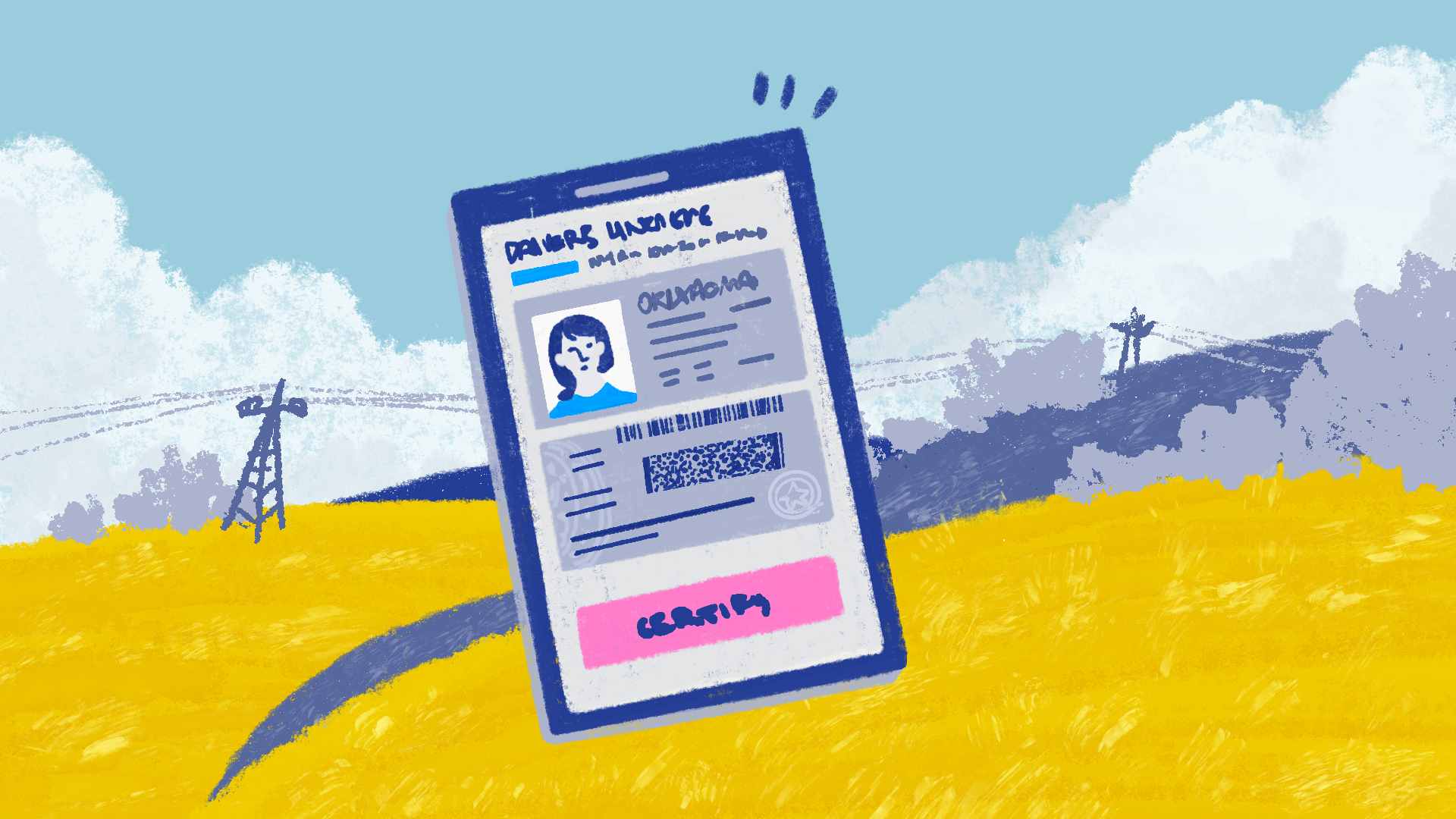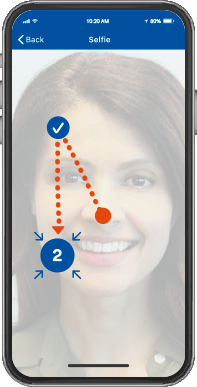
Oklahoma Mobile ID is an app that can store a secured, digitized version of a driver’s license or state-issued ID. Residents can use the app as a means to verify their identity. Unfortunately, the app is not accessible to individuals with vision disabilities.
“It’s currently the ONLY form of mobile-phone-based ID that is verifiable against the record created by DPS when you applied in person for a driver’s license or state ID,” states Oklahoma Mobile ID frequently asked questions.
The digitized ID can be used like a driver’s license or state-issued identification. A physical driver’s license is still required when boarding a plane or requested by law enforcement.
According to a U.S. Department of Justice letter (PDF) of findings, a resident, who is blind, filed a complaint because they could not take a photo of the front and back of the ID. The person could not take a picture of themselves because they can’t connect the dots on the screen using only head and eye movements. The letter indicates the Justice Department found the Oklahoma mobile app inaccessible.
In this episode of A11y Insights, Ken Nakata from Converge Accessibility and Equal Entry CEO and founder Thomas Logan talk about a decision in a lawsuit in Oklahoma regarding a mobile ID app.
Allegations of App Noncompliance
Thomas Logan: Ken, let’s talk about some new developments in Oklahoma with a mobile application. There’s a lawsuit in Oklahoma regarding this new idea of having a mobile ID where, instead of having to carry around your driver’s license or your state-issued ID for identification, you can use an application on your phone to do this.
What do you know about this problem that’s been found with this app?
Ken Nakata: I know that the Justice Department looked into this because they recently issued a Service Oklahoma Letter of Findings against the Service Oklahoma OK Mobile ID application, finding that it violated Title II of the ADA.
Thomas Logan: It looks like what was at least at fault or one of the main areas at fault was this idea that to be able to have a mobile ID, you need to complete this task of scanning your face and also showing the front and back of your real driver’s license or your state-issued identification.
It was specifically this idea of taking pictures of the front and back and also manipulating your face in front of the camera. That was the problem, right?
Ken Nakata: I looked at this letter of findings more carefully. It looks like you don’t have to have a Real ID to start the process for the mobile ID.
The mobile ID could be used to start the process of getting a Real ID. I guess that’s why they wanted to do things like do a full facial scan. Although, I wonder whether that is something that the state should be doing when a person comes in to get their Real ID.
Thomas Logan: Absolutely. It’s an interesting area. I know that for myself, I want to have everything on my phone. There are often times when I don’t even want to carry a wallet anymore.
When you have everything, such as credit cards going through your phone, I guess having your identification on your phone, you can see why it’s beneficial and why it’s something that people will want. But it looks like it’s difficult to get this thing set up.
Ken Nakata: This is such a benefit for everybody. There are plenty of times when I’ll go running or bicycling. The last thing in the world I want to do is carry it around my wallet and I don’t want to risk taking my driver’s license because I could lose it.
It could fall out of my pocket. It’s such a valuable form of identification that I’d want to keep it at home in a safe place and keep a digital copy available that I could use when I’m out and about.
Using the Mobile ID App
Thomas Logan: Absolutely and I think just drilling down into what’s being alleged here, from my investigation, I’ve looked up who built this Oklahoma mobile application.
And it looks like it’s this company called IDEMIA, but they’ve built the same solution for other states as well. The application — although I haven’t been able to try it — the app looks basic. It’s a pretty simple application. The main piece is this idea of needing to take a selfie where you connect a sequence of dots.
And 21 different dots that appear on the screen as the next image shows an example. It looks like they’re trying to use these dots to get people to move their faces around to get a good facial scan. If I’m someone who’s blind and I don’t get any information, and we’re just supposed to look at the visual on the screen, I see this area of non-compliance.

To me, when I look at the implementation, I think, well, there’s probably a way to do that with audio alerts or audio prompts, the same way that a person who’s blind can take a photograph and find out how many people are in the photograph, and if the faces are lined up.
I feel like there should be a way. And not a very difficult way to make this accessible for someone who’s blind or has low vision, so that they can also just get some information on how to complete the task. What do you think?
Ken Nakata: I think that it sounds as though they have to move their faces in different directions and an audio prompt could just as easily say, “Hey, could you move to the left because you’re not in the frame, or move to the right because you’re not centered in the frame, and turn your face to the left, and look up to your left, look straight up, look up to the right.”
It’s kind of like getting a visual test. Those are the prompts that my eye doctor gives me to look around. There’s no reason why a prompt couldn’t just as easily tell a person to point their face in those different directions to get the full visual scan of their face.
Testing with People with Disabilities
Thomas Logan: Just to end this discussion, this idea of using the web content accessibility guidelines for mobile apps and, or thinking about other ideas to work, I know you mentioned just as we were preparing for this talk, it’s like, “Well, you could just test with people with disabilities.”
I do think, yes, if they had set this app in front of even one blind person, they could have found out, “Hey, it doesn’t work.” What are your thoughts on just how they should have thought about this or how it could have been improved before having to get to this stage?
Ken Nakata: I think that they should have included people with disabilities when they’re coming up with the testing for this app into development.
I think that’s one of the things that also kind of bothers me with how the Justice Department approached the letter of findings and the remedial measures that they’re taking. There are some basic tasks that they should require people with disabilities to do in their testing when they’re coming up with this app.
Instead, the Justice Department said that as part of the settlement Oklahoma had to make sure that the application complied with WCAG 2.1 A and AA, which to me sounds fine. But it doesn’t give that much guidance to a developer because WCAG is confusing enough already.
In reality, I’m not sure that a developer is going to look at WCAG and necessarily conclude that they have to use those basic use cases and test cases, such as having the prompts to make sure that a user with a disability points their face in the right direction to make sure that they get a full visual scan.
Maybe they would, maybe they wouldn’t, but just saying WCAG, I don’t think gives them very good guidance when they should say, “Make sure that this application is tested and is completely usable by people with various disabilities.”
Thomas Logan: I agree. I think this app appears to be such a simple app with a straightforward workflow. You could have that understanding, be communicated by watching. And again, I said it, you probably don’t even have to test with more than one blind person to get this feedback.
Maybe still the benefit for multiple people trying it, but probably the very first person that sits down with it and if the developer of this application saw the user experience, they would be able to think of those ideas and come up with different solutions. I think that would be a more realistic way to come up with a solution than giving someone hundreds of pages of WCAG as to what they need to do to think about this problem.
Ken Nakata: Exactly.
Thomas Logan: Thanks for the conversation.
I’m curious what you think. So, let us know in the comments. Have you used one of these mobile ID apps? LinkedIn, for example, uses one to verify people with their driver’s license or state-issued ID. How was the experience? Let us know and we’d like to continue the discussion.
Have you received a legal demand letter?
Legal demand letters are on the rise. With years of experience partnering with ADA attorneys and providing expert witness testimony, we have a unique perspective when it comes to explaining and justifying our clients’ accessibility compliance that will help suffice your legal requirements.
If you are experiencing any legal issues related to the accessibility of your technology, please contact us to discuss how we can help.
I think it’s a good idea